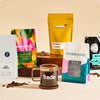The funny thing about water is that just because it’s clear doesn’t mean there isn’t stuff in it, which is the reason that it’s important to know about descaling.
“Scale” in this case doesn’t mean the thing you weigh your coffee grounds on, but instead means the buildup of calcium, magnesium, and other minerals that’s left after boiling water evaporates. You’ve probably seen it before, especially if you live somewhere with especially hard water: It might look a bit like a white film on metal surfaces, or grime inside your coffee brewer’s water reservoir. It’s nontoxic, but there are plenty of good reasons you’ll want to learn how to clean your machine regularly. If you’re wondering how to descale a coffee maker, you’ve come to the right place.
What causes scale buildup?
When you brew coffee at home your kettle heats your water to a boil, some of the water evaporates, leaving behind a deposit of the minerals it contains. Some types of water have more to leave behind than others, and some don’t have any: Distilled water is completely pure H2O (but it also wreaks havoc on coffee and coffee-making equipment, so do you your best to avoid using it). The Specialty Coffee Association water standard states that acceptable calcium hardness in brewing water is between 50 and 175 parts per million, primarily for flavor reasons: Too many or too few minerals in your water can lead to an under- or over-extracted coffee brew.
If you boil and re-boil the same water, or if you start your brew with hot water from the tap, you may find that the problem is exacerbated — and that your coffee doesn’t taste as good. One good practice to avoid heavy scale buildup is to always start with fresh, cold water. Plumbed espresso machines are particularly susceptible to scale buildup for this reason: Water sitting in the boiler is exposed to more heat for longer periods of time than in machines that have a pass-through brewing reservoir. An inline water filter or even something as simple as a charcoal Brita filter can help delay the inevitable, but chances are you’ll need to descale at some point, so we may as well learn how (and why).
Why is scale bad for my brew?
There are a couple of reasons scale buildup isn’t the best part of waking up. For one thing, if you let it get bad enough in your kettles or inside the once clean water tanks of your brewers, it can contribute off flavors or interfere with your coffee extraction.
If left to its own devices long enough, it may also begin to clog or coat essential parts of the machine, like the water flow tubes, spray heads, the heating element, probes, and gauges, which can prevent the machine from functioning properly and may even cause long-term equipment damage. Espresso boilers filled with scale, for instance, may stop reading the internal temperature and pressure accurately, which can not only lead to breakdown but also dangerous levels of heat and steam. Spray heads filled with limescale and calcium buildup won’t disperse the clean water evenly over your coffee grounds. And the longer it sits, the harder it can be to remove.
How can I descale my setup?
Don’t sweat the scale stuff: There are plenty of ways to make sure your equipment is clean and that sweet, sweet coffee keeps flowing at its best. When it comes to learning how to clean coffee brewing equipment, there are lots of descaling products available out there. Here are two examples:
Urnex is a commercial coffee-machine cleaning product manufacturer, and their bottles of descaler, milk-buildup remover, group-head cleaners, and grinder tabs can be found in top cafés all over. They’ve also developed some citric-acid-based home-use cleaning products, such as a Coffee Maker Descaler that is easy to use on automatic brewers and kettles.
Coffee equipment manufacturer Saeco also has its own line of decalcifier liquid, which can be used safely in espresso machines and also contains citric and lactic acids to break down the mineral deposits.
You may be thinking, “Can I just use distilled white vinegar?” Technically speaking, yes: Distilled white vinegar will remove scale from your coffee machines if you use enough of it and let it sit long enough — but then you also run the risk of having morning coffee that tastes slightly reminiscent of pickles for the rest of the machine’s life. Coffee equipment with plastic or rubber components, such as automatic drip brewers, tend to absorb the smell of vinegar and refuse to let it go. While it seems like a cheap and readily available cleaning option, we recommend avoiding the temptation.
However, you can DIY a descaler, if you’d like to have more control over what goes into the thing your precious coffee comes out of: Most commercially available products are made with a base of citric acid, which you can buy at many grocery stores or canning-supply shops. Citric acid has a lower pH than vinegar, so the process may take a bit longer overall, but it will be done without any lingering taste or aroma — squeaky clean!
A descaling solution, whether its in powder or liquid form, require a couple hours’ investment: There may be soaking, thorough rinsing, and the occasional elbow grease involved. That said, as soon as you descale your machine you can get back to getting so overcaffeinated that you’d like to scale the walls — and isn’t that the point?
If you’re a coffee fanatic, take our coffee quiz to determine what brew is best for you. Whether it’s for your morning cup or an evening sip after work, Trade has all your coffee needs at your fingertips.





